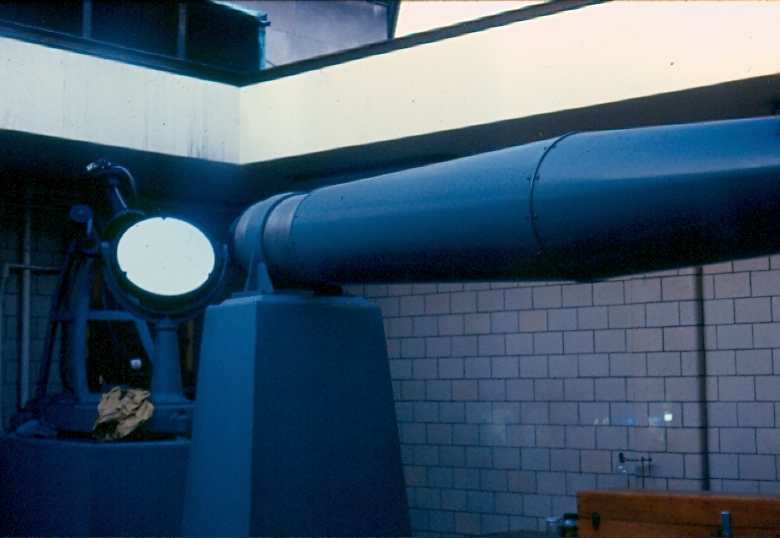
Photographs of a Penumbral Lunar
Eclipse in January of 1999 shows the
dimming of the Southern Hemisphere
of the Moon (left photo) compared to
the Moon seen outside of the Earth's
shadow (right photo).
(Image Sources: Wikipedia.org , By
SockPuppetForTomruen (talk) - I
created this work entirely by myself.
Transferred from en.wikipedia, Public
Domain, https://commons.wikimedia.org/
w/index.php?curid=17097701 )
By Glenn A. Walsh
Reporting for SpaceWatchtower
Early on Wednesday Morning, 2016 March
23, very observant viewers may be able to see a dim Penumbral Eclipse
of the Moon or Lunar Eclipse.
A Penumbral Eclipse of the Moon is dimmer than a Partial Eclipse of the Moon. During an eclipse of the Moon, the Earth's solar shadow shines on part or all of the Moon, at the time of the Full Moon. The Earth actually casts two shadows: the main and darker Umbral Shadow along with the secondary and dimmer Penumbral Shadow.
In the case of a Total Lunar Eclipse, the Earth's Umbral Shadow completely envelops the Moon. In the case of a Partial Eclipse of the Moon, only part of the Moon is covered by the Umbral Shadow. In the case of a Penumbral Eclipse of the Moon, only the dimmer Penumbral Shadow covers part or all of the Moon.
A Penumbral Eclipse of the Moon is dimmer than a Partial Eclipse of the Moon. During an eclipse of the Moon, the Earth's solar shadow shines on part or all of the Moon, at the time of the Full Moon. The Earth actually casts two shadows: the main and darker Umbral Shadow along with the secondary and dimmer Penumbral Shadow.
In the case of a Total Lunar Eclipse, the Earth's Umbral Shadow completely envelops the Moon. In the case of a Partial Eclipse of the Moon, only part of the Moon is covered by the Umbral Shadow. In the case of a Penumbral Eclipse of the Moon, only the dimmer Penumbral Shadow covers part or all of the Moon.
Of course, weather conditions have to
be clear to have a chance to see this eclipse. A Lunar Eclipse or
Eclipse of the Moon is the type of eclipse which is safe to look at with
the naked-eyes, binoculars, and telescopes. However, the shading of
the Moon during such a Penumbral Eclipse is extremely subtle, and not
everyone may be able to tell when the eclipse is occurring.
The entire eclipse could be visible to
viewers in western North America, Hawaii, Alaska, eastern Australia, New
Zealand, Japan, and the Pacific Ocean. Part of the eclipse, before
local moon-set, would be visible in eastern North America and South
America. Parts of central and eastern Asia could experience part of
the eclipse after local moon-rise. Europe and Africa will not
experience this eclipse at all.
Times of Eclipse Phases
(EDT
= Eastern Daylight Saving Time; UTC = Coordinated Universal Time)
Penumbral Lunar
Eclipse Begins: 5:39:28 a.m. EDT / 9:39:28 UTC
Greatest Penumbral
Lunar Eclipse: 7:47:13 a.m. EDT / 11:47:13 UTC
Moon Phase - Full
Moon: 8:01 a.m. EDT / 12:01 UTC
Penumbral Lunar
Eclipse Ends: 9:54:54 a.m. EDT / 13:54:54 UTC
Special Note: Although the times given for the beginning and ending of the Penumbral Eclipse are the correct times, it is highly unlikely that the beginning and ending can be viewed visually. Observations of when the Penumbral Eclipse is first visible, and when the Eclipse is no longer visible, would be valuable to Science. On average, a Penumbral Eclipse is only visible a half-hour before until a half-hour after the time of greatest eclipse.
And, that bright star-like object near the Moon is the planet Jupiter.
More on the Penumbral Lunar Eclipse of 2016 March 23 ---
Link 1 >>> http://eclipse.gsfc.nasa.gov/LEplot/LEplot2001/LE2016Mar23N.pdf
Link 2 >>> https://en.wikipedia.org/wiki/March_2016_lunar_eclipse
More about a Lunar Eclipse or Eclipse of the Moon:
Link >>> https://en.wikipedia.org/wiki/Lunar_eclipse
Source: Glenn A. Walsh Reporting for SpaceWatchtower, a project of Friends of the Zeiss.
2016 March 22.

2016: 75th Year of Pittsburgh's Buhl Planetarium Observatory
Link >>> http://buhlplanetarium2.tripod.com
Like This Post? - Please Share!
Want to receive SpaceWatchtower blog posts in your inbox ?
Send request to < spacewatchtower@planetarium.cc >..
gaw
Glenn A. Walsh, Project Director,
Friends of the Zeiss < http://buhlplanetarium.tripod.com/fotz/ >
Electronic Mail - < gawalsh@planetarium.cc >
SpaceWatchtower Blog: < http://spacewatchtower.blogspot.com/ >
Also see: South Hills Backyard Astronomers Blog: < http://shbastronomers.blogspot.com/ >
Barnestormin: Writing, Essays, Pgh. News, & More: < http://www.barnestormin.blogspot.com/ >
About the SpaceWatchtower Editor / Author: < http://buhlplanetarium2.tripod.com/weblog/spacewatchtower/gaw/ >
SPACE & SCIENCE NEWS, ASTRONOMICAL CALENDAR:
< http://buhlplanetarium.tripod.
Twitter: < https://twitter.com/spacewatchtower >
Facebook: < http://www.facebook.com/pages/
Author of History Web Sites on the Internet --
* Buhl Planetarium, Pittsburgh:
< http://www.planetarium.
* Adler Planetarium, Chicago:
< http://adlerplanetarium.
* Astronomer, Educator, Optician John A. Brashear:
< http://johnbrashear.tripod.com >
* Andrew Carnegie & Carnegie Libraries:
< http://www.andrewcarnegie.
* Civil War Museum of Andrew Carnegie Free Library:
< http://garespypost.tripod.com >
* Duquesne Incline cable-car railway, Pittsburgh:
< http://inclinedplane.tripod.
* Public Transit:
< http://andrewcarnegie2.tripod.
It's going to be finish of mine day, except before ending I am reading this impressive paragraph to increase my know-how. Jaipur Escort | Jaipur Escort Service | Female Escort Jaipur | Jaipur Escort |
ReplyDelete